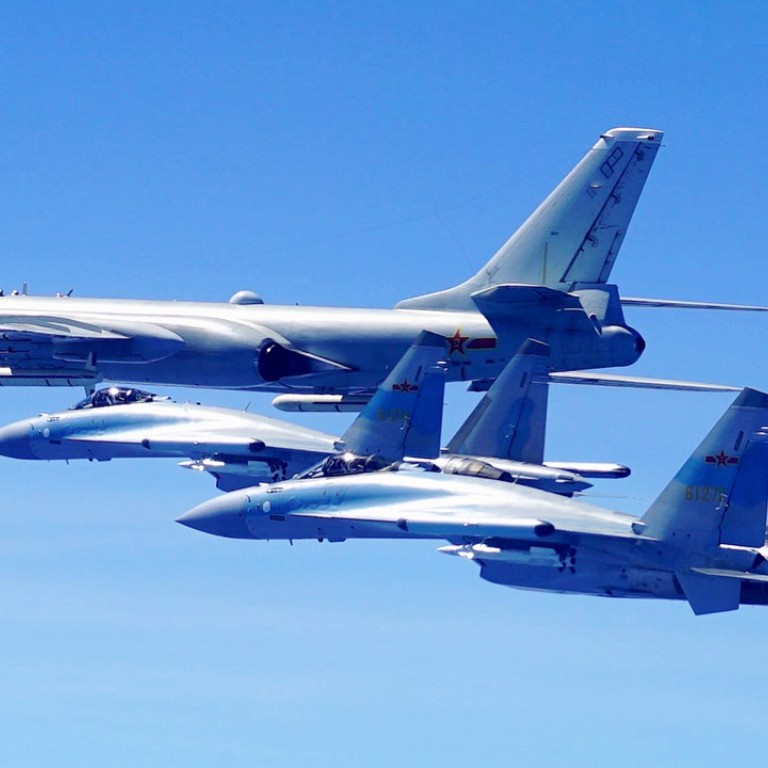
China angers US after landing warplanes, including H-6K bomber, on South China Sea reef
Pentagon condemns military activity as ‘raising tensions and destabilising the region’
A Chinese People’s Liberation Army (PLA) Air Force strategic bomber landed for the first time on an island reef in the South China Sea, something the US Department of Defence said “serves to raise tensions and destabilise the region”.
A spokesman for the Pentagon, Lieutenant Colonel Christopher Logan, called the exercise an act of “China’s continued militarisation of disputed features in the South China Sea”.
The Chinese air force said in a statement on its website that several bombers, including the H-6K, its most advanced, had conducted take-off and landing training on an island reef, though it did not specify which one.
Hong Kong-based military observer Song Zhongping said the aircraft landed on Woody Island – or Yongxing in Mandarin – the largest of the Paracel group and southernmost of the islands claimed by Beijing in the disputed waterway.
The aim of the exercise was to strengthen China’s military presence in the region, after the US air force flew B-52 bombers there during a so-called routine training mission in April, which Beijing described as “provocative move”, Song said.
The air force said the latest exercise had elevated its abilities of “reaching its full territory, assaulting in full time and space, and striking in full scope”.
Military expert Wang Minliang was quoted in the statement as saying the bombers’ training mission was necessary “to enhance the real combat ability against all kinds of security threats in the sea”.
Song, who works as a military commentator for Phoenix TV, said the next mission for the long-range H-6K strategic bomber, which is reported to have a combat range of up to 3,500km, might be to land on China’s furthest outlying artificial islands.
“To boost China’s military presence and give the PLA better control in the region, it’s possible the H-6K will fly further in the future, to the airstrips on Fiery Cross, Subi and Mischief reefs [in the Spratly Islands],” he said.
Each of the three reefs features an airstrip, high-frequency radar and other monitoring equipment, and lighthouses.
“In the future, the air force will conduct regular landings on Woody and the man-made islands, although they are not yet developed enough to be permanent military bases,” Song said.
People’s Daily, the Chinese Communist Party’s official newspaper, on Friday posted a video on its Twitter account of the H-6K bomber’s training programmes.
Bonnie Glaser, a China security expert at the Centre for Strategic and International Studies in Washington, agreed that the location of the H-6K landing was Woody Island, which is also home to the administrative headquarters of the Sansha city government.
Beijing established Sansha, a prefecture-level city in Hainan province, in 2012 to administer the Paracel, Spratly and Zhongsha island groups, and their surrounding waters.
“I believe this is the first time a bomber has landed in the South China Sea,” Glaser said. “No doubt the H-6K will soon land on an island in Spratly, as the hangers there are built to accommodate bombers.”
Earlier this month, the White House said it was prepared to take measures against the militarisation of the South China Sea, after Beijing reportedly installed new missiles on outposts in the Spratlys – known as Nansha in Mandarin – that are also claimed by Vietnam and the Philippines.
“We’re well aware of China’s militarisation of the South China Sea. We’ve raised concerns directly with the Chinese about this, and there will be near-term and long-term consequences,” White House spokeswoman Sarah Sanders said.
US network CNBC reported that the Chinese military had installed anti-ship and air-to-air defences on the islands, citing sources close to US intelligence.
China’s foreign ministry spokeswoman Hua Chunying refused to confirm or deny the deployment.
“China’s peaceful construction in the Spratly archipelago, including the deployment of necessary national defence facilities, is aimed at protecting China’s sovereignty and security,” she said. “Those who don’t intend to violate [this sovereignty] have no reason to worry.”
The US Navy itself frequently sends warships and aircraft carriers to patrol the area.
“China has to realise that they’ve benefited from the free navigation of the sea, and the US Navy has been the guarantor of that,” Pentagon spokeswoman Dana White said. “We will continue to do our operations.”
Additional reporting by Minnie Chan

